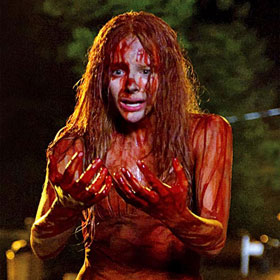'Carrie' Review: Not-So-Horrifying Remake Of A Stephen King Classic

3/5
The newest film adaptation of Stephen King's Carrie is decent, but fails to truly scare and horrify the audience.
2013’s Carrie follows Carrie White (Kick-Ass’s Chloë Grace Moretz), an introvert victimized by her classmates and her fanatical, self-mutilating mother Margaret (Julianne Moore). How crazy is Margaret? When in labor with Carrie, Margaret believed that the baby was a cancer and nearly killed it. Carrie’s telekinetic powers just so happen to manifest themselves on the same day she gets her period. Margaret never told Carrie about periods, so when Carrie gets hers, she is so frantic and humiliated in the locker room that she accidentally suspends a popular girl, Chris Hargensen (Portia Doubleday), in the air, spurring her to enact revenge on Carrie at prom. When Carrie returns home, furious Margaret locks her in her prayer closet to ask God for forgiveness.
As the film progresses, Carrie realizes her powers and hones them. Another popular girl, Sue Snell (Gabriella Wilde), owns up to her guilt and begs her boyfriend Tommy (Ansel Elgort) to take Carrie to the prom. Though Carrie is hesitant, she ultimately agrees and attends the prom despite her mother’s disapproval. What happens next involves gratuitous amounts of pig blood and fire.
Carrie is not a gorefest, but it’s not much of a thriller either. There is blood and violence and cruelty, but they are low-grade, so the scare factor decreases considerably. The histrionic soundtrack might have made the film a little less affective, as well. That said, as a fan of the 1976 film version of Carrie, I may have spent too much time quietly comparing the movie to Brian De Palma’s film or King’s novel.
Carrie, Stephen King’s 1974 thriller about a telekinetic misfit, has been adapted several times for the small and silver screens, the most notable being the 1976 adaptation starring Sissy Spacek. Directed by De Palma, the 1976 horror was so good because it was one of the first, if not the first, to make prom night terrifying. Who can forget bloodied Carrie (Spacek) unleashing hell on her school with a bug-eyed, vacant stare? Unfortunately, the most recent adaptation from director Kimberley Peirce does little to re-imagine its literary and cinematic predecessors.
The acting is subpar, but sufficient, yet I did enjoy some of the performances. Moretz holds steady in such a famous role. Her performance isn’t memorable, but it does elicit sympathy from the viewer. She has such a sweet, innocent face that it was difficult to accept her monstrous transformation at the end. Like Spacek, she’s not physically unattractive, as the book describes her character. Also, she is much more expressive and fluid, especially during the massacre at the end, where she seems to derive pleasure from the surrounding chaos. Elgort and Wilde are beautiful to look at, but they don’t offer much else. It’s a shame, since Wilde’s character Sue figured in as a major point of view in the novel. Judy Greer is compassionate as Carrie’s teacher, but forgettable. Moore, however, is simply chilling as Margaret. She seesaws between periods of fanatical threats and tender words. Piper Laurie did the role justice in 1976, and Moore follows in her footsteps perfectly. If for nothing else, I’d recommend watching the movie solely for Moore’s performance.
The most significant difference between director Peirce’s retelling and previous adaptations is the presence of cyber-bullying. Good old-fashioned gossip was prevalent in the ‘70s, but not today. I found the bullying to be the most horrific part – not the violence or the blood or Margaret's self-mutilation, but the ease with which the classmates tortured Carrie. Cruelty and bullying remain a very real and serious problem in schools. Though the novel and the original film were products of their time, Carrie is, in its basic form, a story about bullying. And that’s why it resonates with us, even today.
Get Uinterview's FREE iPhone App For Daily News Updates here.
Get the FREE Uinterview iPad app here and watch our videos anywhere.
RELATED ARTICLES
Get the most-revealing celebrity conversations with the uInterview podcast!







Leave a comment